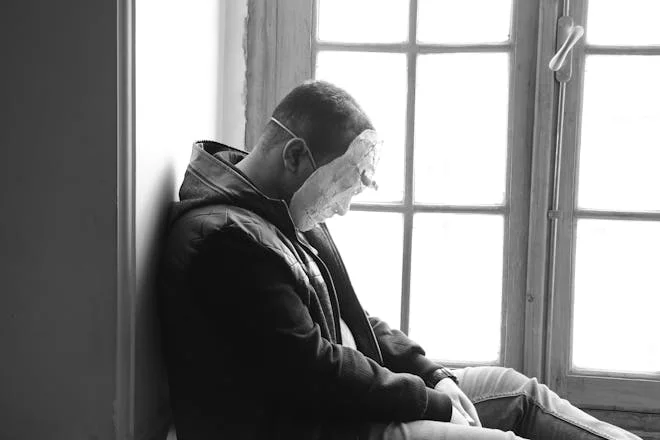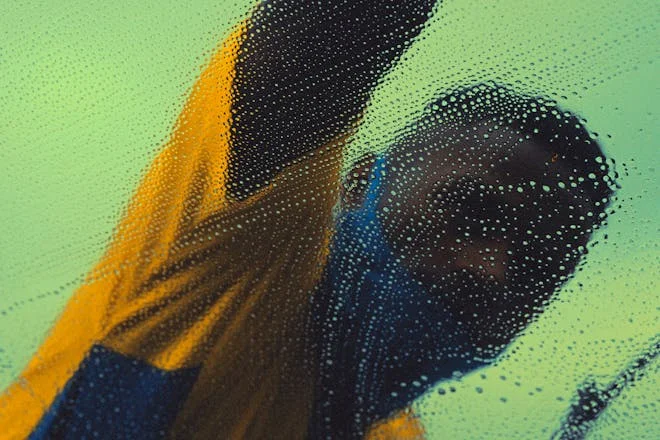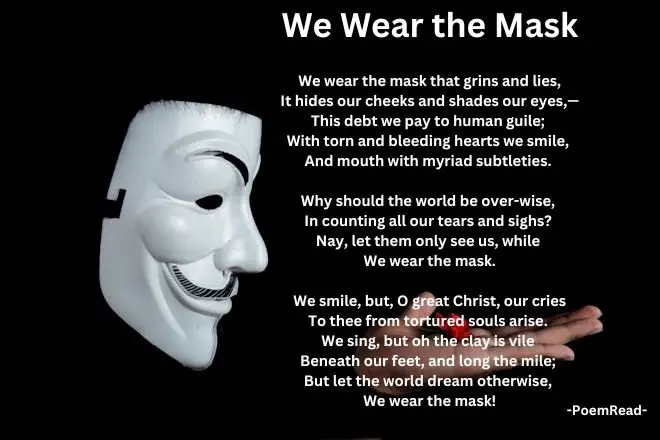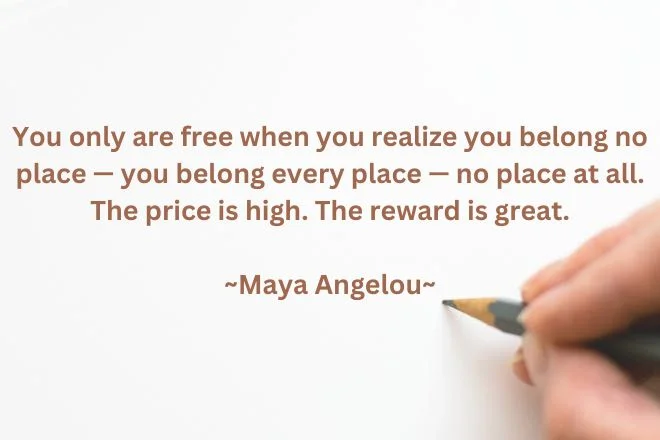
About the Poem “We Wear the Mask” by Paul Laurence Dunbar
When it comes to exploring the complexities of human nature and the masks, we wear to conceal our true emotions, few poems capture the essence as powerfully as “We Wear the Mask” by Paul Laurence Dunbar.
In this blog post, we will examine various literature-related aspects of this thought-provoking poem, including its subject, the author, the context, the theme and tone, and the form or structure that Dunbar employs.
We Wear the Mask
BY PAUL LAURENCE DUNBAR
We wear the mask that grins and lies,
It hides our cheeks and shades our eyes,—
This debt we pay to human guile;
With torn and bleeding hearts we smile,
And mouth with myriad subtleties.
Why should the world be over-wise,
In counting all our tears and sighs?
Nay, let them only see us, while
We wear the mask.
We smile, but, O great Christ, our cries
To thee from tortured souls arise.
We sing, but oh the clay is vile
Beneath our feet, and long the mile;
But let the world dream otherwise,
We wear the mask!
Content
- The Author: Paul Laurence Dunbar
- The Subject of "We Wear the Mask"
- Context of "We Wear the Mask"
- Theme of "We Wear the Mask"
- Tone of "We Wear the Mask"
- Form and Structure of "We Wear the Mask"
- Line-by-line analysis of "We Wear the Mask" by Paul Laurence Dunbar
- Poetic and Literary Devices of "We Wear the Mask"
- Implications of "We Wear the Mask"
- Interactive Summary of "We Wear the Mask"
The Author: Paul Laurence Dunbar
Before we dive into the poem itself, it is important to understand the background of its talented creator, Paul Laurence Dunbar. Born in 1872, Dunbar was an influential African American poet, novelist, and playwright. He was one of the first African American writers to gain national recognition. His works often explored the experiences and struggles of black individuals in America during the late 19th and early 20th centuries.
The Subject of “We Wear the Mask”
Dunbar’s poem explores the subject of masks—not the physical ones we wear for festivities, but the metaphorical masks we don to conceal our true emotions and realities. Dunbar highlights the dichotomy between outward appearances of joy and the hidden pain and suffering of marginalized communities through vivid imagery and poignant language.
The poem’s title, “We Wear the Mask,” immediately sets the thematic tone, inviting readers to explore the complex layers of societal expectations and personal struggles. The mask becomes a powerful symbol of the facade individuals must maintain to navigate a world that often refuses to acknowledge their humanity.
The Mask as a Survival Strategy
In the context of racial oppression, the mask takes on added significance. African Americans, facing relentless discrimination and violence, were often compelled to wear a mask of false happiness and contentment. This mask served as a survival strategy, shielding them from further harm while concealing the anguish and turmoil within.
Dunbar’s choice of “grins and lies” in the opening line underscores the performative nature of the mask. It hides the pain etched on their faces and veils the truth behind forced smiles. The mask becomes a coping mechanism, a necessary guise to navigate a society that demands conformity while disregarding humanity.
Unveiling the Truth
Through “We Wear the Mask,” Dunbar invites readers to peer beyond the superficial and confront the harsh realities faced by marginalized communities.
The enduring relevance of the poem lies in its ability to spark conversations about authenticity and resilience. It also delves into the enduring impact of societal expectations on individual lives.
Essentially, “We Wear the Mask” serves as a commentary on the human condition. It urges us to unmask our truths, embrace vulnerability, and work towards a world where authenticity prevails over pretense.
Context of “We Wear the Mask”
The context of Paul Laurence Dunbar’s “We Wear the Mask” is inseparable from the African American experience in the aftermath of the Civil War. Even though the war had ended, the harsh reality of extreme racism and hardship overshadowed the anticipated improvement in the lives of black Americans.
Published in 1895, the poem reflects a period of deceptive progress. The appearance of freedom during this time period was in direct opposition to the persistence of segregation and discrimination.
Dunbar’s work is a response to this era, capturing the emotional toll of living in a society that demanded a cheerful demeanor as a means of survival. The mask in the poem is a metaphor for the emotional disguise that African Americans had to adopt to navigate a world that was unsympathetic and prejudiced against them. It wasn’t just a personal struggle but a collective one, where the mask became a symbol of resilience and a tool for enduring the societal pressures of the time.
The poem’s universal message extends beyond race, resonating with any marginalized group forced to present a brave face to survive in an oppressive environment. Dunbar’s “We Wear the Mask” thus stands as a testament to the enduring spirit of a community that, despite the odds, continued to hope and strive for a better future.
Theme of “We Wear the Mask”
The theme of “We Wear the Mask” by Paul Laurence Dunbar explores the intricacies of deception, resilience, and the human experience. Through the metaphor of masks, Dunbar explores the facade that individuals often don to conceal their true emotions and realities. The poem’s thematic richness lies in its exploration of societal pressures, personal struggles, and the enduring resilience of the human spirit.
Masks as Deception and Concealment
At its core, the poem exposes the deception inherent in wearing masks. The “grins and lies” referred to in the opening lines symbolize the false facade individuals adopt to conform to societal expectations. This theme resonates not only in the context of racial oppression but also in broader social and personal contexts. Here, people hide their pain, fears, and vulnerabilities behind a mask of composure.
Resilience Amidst Adversity
Despite the weight of societal pressures and personal hardships, “We Wear the Mask” also celebrates the resilience of individuals. The poem’s speakers, while acknowledging the necessity of wearing masks, also hint at the strength it takes to endure and persevere. The phrase “torn and bleeding hearts, we smile” captures the resilience that emerges from adversity. It emphasizes the unstoppable human spirit that endures despite facing challenges.
Tone of “We Wear the Mask”

The tone of “We Wear the Mask” oscillates between resignation and defiance, reflecting the complex emotions and experiences captured in the poem. Initially, there’s a sense of resignation as the speakers acknowledge the need for masks in a world that often refuses to see beyond appearances. This resignation is mixed with a subtle sense of sadness and exhaustion, as seen in phrases like “our cries to thee from tortured souls arise.”
However, beneath the resigned facade lies an undercurrent of defiance and strength. While the speaker highlights the suffering and despair of their community, the poem ultimately emphasizes community pride through its resistant and dignified tone. From the very beginning, the speaker insists on their community’s capacity to evade the outside world’s penetrating gaze. They present a smiling demeanor to an otherwise threatening world.
The poem’s tone of resistance is subtly conveyed through the careful choice of words and the structure of the verses. The slant rhyme of “lies” and “subtleties” quietly jars against the otherwise rigid rhyme scheme, reflecting the community’s deceptive capacity. The fidelity to traditional meter and rhyme can be interpreted as a kind of mask itself. The speaker uses it to maintain a show of dignity.
In “We Wear the Mask,” Dunbar masterfully intertwines themes of deception, resilience, and the human struggle for authenticity. The poem’s shifting tones—from resignation to defiance—mirror the complexities of navigating societal expectations while maintaining a sense of self. Through vivid imagery and poignant language, Dunbar invites readers to reflect on the masks they wear. He also highlights the enduring strength found in embracing vulnerability and authenticity.
Form and Structure of “We Wear the Mask”
Stanza Structure and Rhyme Scheme
Paul Laurence Dunbar’s “We Wear the Mask” is a finely structured piece that adheres to the rondeau form. This poetic style originated with the French troubadours. This form is characterized by its length, typically consisting of 10–15 lines, and is divided into three stanzas.
The poem is composed of three stanzas: the first is a quintet with five lines, followed by a quatrain of four lines, and concluding with a sestet of six lines. The rondeau’s distinctive feature is its two-part rhyme scheme, which in this case is AABBA AABR AABBAR, where ‘R’ signifies the refrain.
The refrain, “We wear the mask,” plays a crucial role in the rondeau form. It initially appears in the first half of the opening line and then recurs at the end of the second and third stanzas. The repetition of the refrain serves as a haunting echo throughout the poem. It reinforces the central theme of concealment and the societal pressures that necessitate the emotional disguise.
Dunbar’s choice of the rondeau form is particularly apt for the poem’s subject matter. The rondeau was often used for music, which lends the poem a lyrical quality that contrasts with its somber themes. The musicality of the form underscores the poem’s exploration of the performative aspect of the masks we wear. The strict structure reflects the constraints within which individuals must operate.
Meter of “We Wear the Mask”
The meter of Paul Laurence Dunbar’s “We Wear the Mask” is predominantly iambic tetrameter. This indicates that most of the poem’s lines have four iambs. Iambs are metrical feet consisting of an unstressed syllable followed by a stressed syllable. The consistent use of iambic tetrameter gives the poem a rhythmic and musical quality. This is fitting, as the rondeau form has origins in song.
However, there are notable exceptions to this pattern. The refrain “We wear the mask” deviates from the iambic tetrameter, as it contains only two metrical feet instead of four. Additionally, there are slight variations in the rhythm within the poem, such as the introduction of a trochee (a stressed syllable followed by an unstressed syllable) at the beginning of some lines. These variations add emphasis and subtle syncopation to the poem’s flow. They underscore both the thematic content and the speaker’s emotional tone.
Overall, the strict metrical structure can be seen as another layer of the ‘mask’ discussed in the poem. It represents a formal, controlled exterior that contrasts with the turbulent emotions expressed within the verses. The meter, therefore, not only contributes to the poem’s form but also to its thematic depth and resonance.
Punctuation and Line Breaks
The poem’s use of punctuation is deliberate yet minimal. Commas and dashes are strategically placed to create pauses and emphasize certain phrases. For instance, the dash in “And mouth with myriad subtleties” draws attention to the complexity of the masks worn by the speakers, highlighting layers of deception and concealment.
Furthermore, the line breaks in the poem serve as natural pauses. They allow readers to contemplate the significance of each phrase and delve deeper into the emotions conveyed. The strategic placement of line breaks adds a visual and auditory dimension to the poem, enhancing its impact and resonance.
In summary, the form and structure of “We Wear the Mask” are not just a framework for Dunbar’s words; they are an integral part of the poem’s meaning. They echo the complexities of the masks that people, especially those facing discrimination and hardship, must wear.
Line-by-line analysis of “We Wear the Mask” by Paul Laurence Dunbar
“We wear the mask that grins and lies,”
This opening line sets the thematic tone of the poem, introducing the central metaphor of the mask. The use of “grins and lies” suggests a deceptive facade, where individuals conceal their true emotions and realities behind a mask of false happiness and deceit. Furthermore, the poem begins with a collective voice, “we,” indicating that the experience described is shared.
“It hides our cheeks and shades our eyes—”
Here, Dunbar vividly describes how the mask obscures physical features like cheeks. It also shields the eyes, often considered windows to one’s emotions. The mask serves a dual purpose. It covers the cheeks, possibly hiding evidence of tears. It also shades the eyes, a window to the soul. This blocks any insight into the wearer’s true emotions. Therefore, this line reinforces the theme of concealment and the duality between outward appearances and inner turmoil.
“This debt we pay to human guile;”
The mention of “debt” suggests a burden or obligation imposed by societal expectations and pressures (“human guile”). Individuals feel compelled to wear the mask as a form of survival, navigating a world that demands conformity while often disregarding their true selves.
“With torn and bleeding hearts we smile,”
This line juxtaposes the outward smile with the internal suffering (“torn and bleeding hearts”). It highlights the emotional toll of wearing the mask and the pain hidden beneath the facade of happiness.
“And mouth with myriad subtleties.”
The expression “mouth with myriad subtleties” highlights how the masks people wear are intricate and full of subtle expressions and gestures. These nuances are used to deceive or hide one’s true feelings, emphasizing the complexity and skill required to maintain a facade.
“Why should the world be over-wise,”
Here, Dunbar questions why society feels the need to scrutinize and analyze every aspect of individuals’ lives, including their hidden pain and struggles. The speaker questions the value of the world’s wisdom if it only serves to count their “tears and sighs,” suggesting that perhaps ignorance is bliss for those who do not suffer as they do. The term “over-wise” suggests an excessive focus on appearances rather than delving deeper into understanding the complexities of human experiences.
“In counting all our tears and sighs?”
This line further emphasizes the theme of scrutiny and judgment, as the speaker questions why the world is so preoccupied with tallying the sorrows (“tears and sighs”) of others. It challenges societal norms that prioritize surface-level judgments over empathy and understanding.
“Nay, let them only see us, while”
The word “Nay” signals refusal or rejection of societal expectations. The speaker wants selective visibility, preferring others to see only the outward facade (“us, while”) instead of uncovering the hidden truths beneath the mask. Furthermore, the speaker asserts their choice to conceal their true selves from the world, emphasizing the act of wearing the mask as a deliberate decision.
“We wear the mask.”
The repetition of the titular phrase reinforces its significance and serves as a refrain throughout the poem. It becomes a declaration of resilience and survival, acknowledging the necessity of wearing the mask while also hinting at the underlying strength and agency of the speakers.
“We smile, but, O great Christ, our cries”
This line juxtaposes the outward smile with the inner anguish and cries for help. The invocation of “O great Christ” adds a spiritual dimension. Additionally, this highlights the speakers’ plea for understanding and relief from their burdens.
“To thee from tortured souls arise.”
The metaphor of “tortured souls” emphasizes the extreme suffering those who must wear the mask go through. The cries rising to a higher power suggest a yearning for redemption and liberation from the masks they are compelled to wear.
“We sing, but oh the clay is vile”
Here, Dunbar introduces a metaphorical contrast between singing (symbolizing outward expressions of joy or contentment) and the “vile clay” beneath their feet. The clay represents the harsh realities and hardships of life, contrasting with the superficial appearances of happiness. Therefore, this line suggests that the foundation of their existence, possibly society itself, is corrupt or unpleasant.
“Beneath our feet, and long the mile;”
This line extends the metaphor of the journey (“long the mile”) through life’s challenges and struggles. The “vile clay” beneath their feet symbolizes the oppressive forces and obstacles faced by the speakers on their journey. Additionally, the journey of life is described as difficult and long, with “the mile” symbolizing the ongoing struggle for equality and recognition.
“But let the world dream otherwise,”
Despite the hardships, the speaker acknowledges that the world may choose to remain oblivious or indifferent (“dream otherwise”) to their hidden truths and struggles. It reflects a resigned acceptance of societal ignorance or denial.
“We wear the mask!”
The poem concludes with a reaffirmation of the central theme, once again declaring the necessity of wearing the mask. The exclamation mark adds emphasis and conviction, underscoring the enduring resilience and defiance encapsulated in this powerful refrain.
Poetic and Literary Devices of “We Wear the Mask”
Paul Laurence Dunbar’s “We Wear the Mask” is rich with poetic and literary devices that enhance its thematic depth and emotional resonance. Here’s an exploration of some of the key devices used in the poem:
Extended Metaphor
The entire poem is built around the extended metaphor of the mask. It’s not a physical mask, but one that symbolizes the emotional disguises people wear to hide their pain and suffering from the world.
Refrain
The line “We wear the mask” is used as a refrain. It repeats at key points in the poem to emphasize the persistence of the facade that people maintain.
Rhetorical Question
Dunbar employs a rhetorical question in the lines, “Why should the world be over-wise, / In counting all our tears and sighs?” to provoke thought and underscore the futility of revealing one’s pain to an indifferent world.
Imagery
The poem uses vivid imagery to describe emotions. Phrases like “torn and bleeding hearts” and “tortured souls” show the internal suffering hidden by the mask.
Anaphora
The device of anaphora is seen in the repetition of the word “We” at the beginning of lines, which creates a sense of unity and collective experience among those who wear the mask.
Irony
The poem employs irony by contrasting outward happiness with hidden pain. This highlights the difference between how individuals truly feel and how they are compelled to seem.
Symbolism
The mask itself is a powerful symbol of the theme of concealment and the social pressures that compel individuals to hide their true selves. Beyond the mask symbol, other symbols are employed, such as “torn and bleeding hearts” symbolizing internal suffering, and “clay” representing the harsh and challenging aspects of life.
Personification
There are elements of personification, such as “our cries to thee from tortured souls arise,” where emotions and struggles are given human-like qualities, enhancing the emotional impact of the poem.
Invocation
The invocation of “O great Christ” adds a spiritual dimension to the poem, conveying a sense of longing for understanding, redemption, and relief from suffering.
Alliteration
Alliteration is present in phrases like “grins and lies,” which adds a musical quality to the poem and emphasizes the duplicitous nature of the mask.
Assonance
The use of assonance in the repetition of vowel sounds helps to create a harmonious and flowing rhythm, as seen in “shades our eyes” and “smile,” linking the lines and ideas together melodically.
Implications of “We Wear the Mask”

The implications of Paul Laurence Dunbar’s “We Wear the Mask” resonate far beyond its verses, carrying insights into the human experience, societal expectations, and the complexities of identity. Here are some of the key implications drawn from the poem:
Societal Expectations and Conformity
The poem highlights the pressure individuals face to conform to societal expectations, often at the cost of suppressing their true emotions and identities. It prompts reflection on the masks we wear to fit in and the toll it takes on our mental and emotional well-being.
Deception and Authenticity
Through the metaphor of the mask, Dunbar delves into themes of deception and authenticity. The poem challenges us to consider the authenticity of our interactions and the masks we wear to hide our vulnerabilities, raising questions about the importance of honesty and genuine connections.
Injustice and Oppression
The poem’s historical context of racial segregation and oppression adds layers of significance. It sheds light on the systemic injustices faced by marginalized communities and the masks they must wear to navigate a hostile world. This invites discussions on social justice, equality, and the enduring impact of systemic discrimination.
Resilience and Survival
Despite the hardships depicted in the poem, there’s an underlying message of resilience and survival. The speakers, while acknowledging the need for masks, also exhibit strength and resilience in enduring and persevering through adversity. This resilience serves as a source of inspiration and empowerment.
Empathy and Understanding
“We Wear the Mask” prompts empathy and understanding towards others. It encourages us to look beyond surface-level appearances and to empathize with the hidden struggles and pain that others may be experiencing. This fosters a sense of compassion and human connection.
Authentic Self-expression
The poem encourages embracing authenticity and self-expression. By acknowledging the masks we wear, it invites introspection and self-awareness. Furthermore, it encourages us to strive for genuine self-expression and to create spaces where individuals can be true to themselves without fear of judgment or rejection.
Spiritual and Existential Themes
The invocation of “O great Christ” adds a spiritual dimension, hinting at themes of faith, redemption, and the search for meaning amidst suffering. This invites contemplation on existential questions and the role of spirituality in navigating life’s challenges.
In essence, “We Wear the Mask” carries implications that extend beyond its poetic verses, sparking conversations about identity, societal norms, resilience, empathy, and the human condition. It serves as a timeless reminder of the masks we all wear and the complexities of navigating a world that often demands conformity while yearning for authenticity and genuine connection.
Interactive Summary of “We Wear the Mask”
Imagine a world where appearances hide deeper truths, and emotions are veiled behind masks. In Paul Laurence Dunbar’s “We Wear the Mask,” readers embark on a journey of introspection, empathy, and resilience.
Metaphor of the Mask
As you engage with the poem, you encounter a potent metaphor: the mask. This mask, adorned with smiles that conceal lies, serves as a shield for our true selves, camouflaging our pain and struggles as we navigate a society rife with expectations and pressures.
Vivid Imagery and Symbolism
Dunbar’s vivid imagery, such as “torn and bleeding hearts,” lays bare the concealed agony and turmoil beneath the surface. The mask symbolizes not just deception but also conformity, inviting contemplation on the authenticity we sacrifice and the emotional toll of suppressing genuine emotions.
Poetic Devices Enhancing Cadence
The poem’s structured rhyme scheme and strategic enjambment create a rhythmic cadence, drawing readers into its melodic flow. This rhythmic contrast accentuates the disparity between outward appearances and internal turmoil, highlighting the disconnect between smiles and silent suffering.
Themes of Resilience and Defiance
Delving deeper, themes of resilience and defiance emerge. Despite the masks we wear, there’s an indomitable strength that propels us forward. The recurring refrain, “We wear the mask,” becomes a rallying cry of empowerment, reclaiming our agency amidst adversity.
Social Commentary and Empathy
Against the backdrop of racial oppression and injustice, “We Wear the Mask” sparks vital discussions on social justice, empathy, and the enduring impact of discrimination. It urges readers to see beyond surface-level facades, fostering empathy for the hidden struggles faced by marginalized communities.
Encouragement of Authenticity
Ultimately, Dunbar’s poem leaves you with a sense of introspection and empathy. It encourages embracing authenticity, fostering genuine connections, and creating spaces where masks are shed, and true selves can shine.
As you navigate the complexities of life, remember the powerful message of “We Wear the Mask” – that behind every facade lies a story untold, waiting to be heard and understood.
If you enjoyed this analysis, please read the analysis on “Still Here” by Langston Huges which follows a similar setting and themes.
RELATED POSTS
View all



